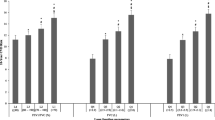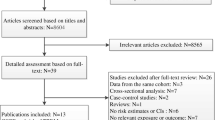Abstract
Purpose
To investigate whether lung function, especially when complicated with SDB, has an increased risk for myocardial infarction (MI) and congestive heart failure (CHF).
Methods
A prospective study was performed within the Sleep Heart Health Study (SHHS). A total of 4161 individuals were followed up for an average of 10.91 years. Forced vital capacity (FVC), forced expiratory volume in one second (FEV1) and the predicted value of FVC and FEV1 were measured to evaluate lung function. The primary outcomes were the MI and CHF. Cox regression analysis was used to investigate the association between reduced lung function and the incidence of MI or CHF. In subgroup analysis, all the individuals were divided into Apnoea–Hypopnoea Index (AHI) < 5 subgroup and AHI ≥ 5 subgroup to explore the relationship.
Results
Lung function were inversely associated with the incidence of MI or CHF. The hazard ratio (HR) and 95% confidence interval (95% CI) for MI and CHF were 0.658 (0.543–0.797) and 0.792 (0.673–0.933) for every 1 L increase in FVC, 0.715 (0.567–0.902) and 0.738 (0.605–0.900) for every 1 L increase in FEV1, 0.986 (0.979–0.993) and 0.989 (0.983–0.995) for every 1% increase in FEV1/pre%, and 0.994 (0.988–0.999) and 0.991 (0.987–0.996) in FVC/pre%, respectively. In addition, the association of lung function with MI and CHF was more prominent in the subgroup with AHI ≥ 5.
Conclusions
Lung function may be associated with incident MI and CHF in this large community cohort of middle-aged and older adults, especially in those with SDB.

Similar content being viewed by others
References
Bhatt SP, Dransfield MT (2013) Chronic obstructive pulmonary disease and cardiovascular disease. Transl Res 162(4):237–251. https://doi.org/10.1016/j.trsl.2013.05.001
Vestbo J, Hurd SS, Agusti AG, Jones PW, Vogelmeier C, Anzueto A et al (2013) Global strategy for the diagnosis, management, and prevention of chronic obstructive pulmonary disease: GOLD executive summary. Am J Respir Crit Care Med 187(4):347–365. https://doi.org/10.1164/rccm.201204-0596PP
McNicholas WT (2009) Chronic obstructive pulmonary disease and obstructive sleep apnea: overlaps in pathophysiology, systemic inflammation, and cardiovascular disease. Am J Respir Crit Care Med 180(8):692–700. https://doi.org/10.1164/rccm.200903-0347PP
Marin JM, Soriano JB, Carrizo SJ, Boldova A, Celli BR (2010) Outcomes in patients with chronic obstructive pulmonary disease and obstructive sleep apnea: the overlap syndrome. Am J Respir Crit Care Med 182(3):325–331. https://doi.org/10.1164/rccm.200912-1869OC
Mannino DM, Gagnon RC, Petty TL, Lydick E (2000) Obstructive lung disease and low lung function in adults in the United States: data from the National Health and Nutrition Examination Survey, 1988-1994. Arch Intern Med 160(11):1683–1689
Putcha N, Crainiceanu C, Norato G, Samet J, Quan SF, Gottlieb DJ et al (2016) Influence of lung function and sleep-disordered breathing on all-cause mortality. A community-based study. Am J Respir Crit Care Med 194(8):1007–1014. https://doi.org/10.1164/rccm.201511-2178oc
Zhang J, Gong Z, Li R, Gao Y, Li Y, Li J et al (2018) Influence of lung function and sleep-disordered breathing on stroke: a community-based study. Eur J Neurol 25(11):1307-e1112. https://doi.org/10.1111/ene.13722
Quan SF, Howard BV, Iber C, Kiley JP, Nieto FJ, O’Connor GT et al (1997) The sleep heart health study: design, rationale, and methods. Sleep 20(12):1077–1085
Lind BK, Goodwin JL, Hill JG, Ali T, Redline S, Quan SF (2003) Recruitment of healthy adults into a study of overnight sleep monitoring in the home: experience of the Sleep Heart Health Study. Sleep Breath 7(1):13–24. https://doi.org/10.1007/s11325-003-0013-z
The ARIC investigators (1989) The atherosclerosis risk in communities (ARIC) study: design and objectives. Am J Epidemiol 129(4):687–702
Ives DG, Fitzpatrick AL, Bild DE, Psaty BM, Kuller LH, Crowley PM et al (1995) Surveillance and ascertainment of cardiovascular events. The Cardiovascular Health Study. Ann Epidemiol 5(4):278–285
Redline S, Sanders MH, Lind BK, Quan SF, Iber C, Gottlieb DJ et al (1998) Methods for obtaining and analyzing unattended polysomnography data for a multicenter study. Sleep Heart Health Research Group. Sleep 21(7):759–767
American Thoracic Society (1995) Standardization of spirometry, 1994 update. Am J Respir Crit Care Med 152(3):1107–1136. https://doi.org/10.1164/ajrccm.152.3.7663792
Miller A (1992) Lung function testing: selection of reference values and interpretative strategies. Am Rev Respir Dis 146(5 Pt 1):1368–1369. https://doi.org/10.1164/ajrccm/146.5_Pt_1.1368b
Rutten FH, Cramer MJ, Lammers JW, Grobbee DE, Hoes AW (2006) Heart failure and chronic obstructive pulmonary disease: an ignored combination? Eur J Heart Fail 8(7):706–711. https://doi.org/10.1016/j.ejheart.2006.01.010
Curkendall SM, DeLuise C, Jones JK, Lanes S, Stang MR, Goehring E Jr et al (2006) Cardiovascular disease in patients with chronic obstructive pulmonary disease, Saskatchewan Canada cardiovascular disease in COPD patients. Ann Epidemiol 16(1):63–70. https://doi.org/10.1016/j.annepidem.2005.04.008
Brekke PH, Omland T, Smith P, Soyseth V (2008) Underdiagnosis of myocardial infarction in COPD—Cardiac Infarction Injury Score (CIIS) in patients hospitalised for COPD exacerbation. Respir Med 102(9):1243–1247. https://doi.org/10.1016/j.rmed.2008.04.010
Donaldson GC, Hurst JR, Smith CJ, Hubbard RB, Wedzicha JA (2010) Increased risk of myocardial infarction and stroke following exacerbation of COPD. Chest 137(5):1091–1097. https://doi.org/10.1378/chest.09-2029
Agarwal SK, Heiss G, Barr RG, Chang PP, Loehr LR, Chambless LE et al (2012) Airflow obstruction, lung function, and risk of incident heart failure: the Atherosclerosis Risk in Communities (ARIC) study. Eur J Heart Fail 14(4):414–422. https://doi.org/10.1093/eurjhf/hfs016
Baum C, Ojeda FM, Wild PS, Rzayeva N, Zeller T, Sinning CR et al (2016) Subclinical impairment of lung function is related to mild cardiac dysfunction and manifest heart failure in the general population. Int J Cardiol 218:298–304. https://doi.org/10.1016/j.ijcard.2016.05.034
Engstrom G, Melander O, Hedblad B (2010) Population-based study of lung function and incidence of heart failure hospitalisations. Thorax 65(7):633–638. https://doi.org/10.1136/thx.2010.135392
Gottlieb DJ, Yenokyan G, Newman AB, O’Connor GT, Punjabi NM, Quan SF et al (2010) Prospective study of obstructive sleep apnea and incident coronary heart disease and heart failure: the sleep heart health study. Circulation 122(4):352–360. https://doi.org/10.1161/CIRCULATIONAHA.109.901801
Ganga HV, Nair SU, Puppala VK, Miller WL (2013) Risk of new-onset atrial fibrillation in elderly patients with the overlap syndrome: a retrospective cohort study. J Geriatr Cardiol 10(2):129–134. https://doi.org/10.3969/j.issn.1671-5411.2013.02.001
Klink M, Quan SF (1987) Prevalence of reported sleep disturbances in a general adult population and their relationship to obstructive airways diseases. Chest 91(4):540–546
Hawrylkiewicz I, Sliwinski P, Gorecka D, Plywaczewski R, Zielinski J (2004) Pulmonary haemodynamics in patients with OSAS or an overlap syndrome. Monaldi Arch Chest Dis 61(3):148–152. https://doi.org/10.4081/monaldi.2004.693
Machado MC, Vollmer WM, Togeiro SM, Bilderback AL, Oliveira MV, Leitao FS et al (2010) CPAP and survival in moderate-to-severe obstructive sleep apnoea syndrome and hypoxaemic COPD. Eur Respir J 35(1):132–137. https://doi.org/10.1183/09031936.00192008
Drager LF, Yao Q, Hernandez KL, Shin MK, Bevans-Fonti S, Gay J et al (2013) Chronic intermittent hypoxia induces atherosclerosis via activation of adipose angiopoietin-like 4. Am J Respir Crit Care Med 188(2):240–248. https://doi.org/10.1164/rccm.201209-1688OC
Shamsuzzaman AS, Winnicki M, Lanfranchi P, Wolk R, Kara T, Accurso V et al (2002) Elevated C-reactive protein in patients with obstructive sleep apnea. Circulation 105(21):2462–2464
Ryan S, Taylor CT, McNicholas WT (2006) Predictors of elevated nuclear factor-kappaB-dependent genes in obstructive sleep apnea syndrome. Am J Respir Crit Care Med 174(7):824–830. https://doi.org/10.1164/rccm.200601-066OC
Schroeder EB, Welch VL, Evans GW, Heiss G (2005) Impaired lung function and subclinical atherosclerosis. The ARIC Study. Atherosclerosis 180(2):367–373. https://doi.org/10.1016/j.atherosclerosis.2004.12.012
Engstrom G, Lind P, Hedblad B, Wollmer P, Stavenow L, Janzon L et al (2002) Lung function and cardiovascular risk: relationship with inflammation-sensitive plasma proteins. Circulation 106(20):2555–2560
McNicholas WT, Bonsigore MR (2007) Sleep apnoea as an independent risk factor for cardiovascular disease: current evidence, basic mechanisms and research priorities. Eur Respir J 29(1):156–178. https://doi.org/10.1183/09031936.00027406
Lavie L (2003) Obstructive sleep apnoea syndrome–an oxidative stress disorder. Sleep Med Rev 7(1):35–51
Acknowledgements
We appreciate the Brigham and Women’s Hospital for sharing the Datasets of Sleep Heart Health Study (SHHS). Besides, SHHS acknowledges the Atherosclerosis Risk in Communities Study, the Cardiovascular Health Study, the Framingham Offspring and Omni Study, the Strong Heart Study, Tucson Epidemiological Study of Obstructive Lung Disease, the cohort studies of respiratory disease in Tucson, and cohort studies of hypertension in New York. SHHS is particularly grateful to the members of these cohorts who agreed to participate in SHHS as well. SHHS further recognizes all of the investigators and staff who have contributed to its success. A list of SHHS investigators, staff and their participating institutions is available on the SHHS website, https://sleepdata.org/datasets/shhs.
Funding
This study was supported by National Natural Science Foundation of China (Grant No. 81770057).
Author information
Authors and Affiliations
Corresponding author
Ethics declarations
Conflict of interest
The authors declare that they have no conflict of interest.
Ethical Approval
All procedures performed in studies involving human participants were in accordance with the ethical standards of the institutional and/or national research committee and with the 1964 Helsinki declaration and its later amendments or comparable ethical standards.
Informed Consent
Informed consent was obtained from all individual participants included in the study.
Additional information
Publisher's Note
Springer Nature remains neutral with regard to jurisdictional claims in published maps and institutional affiliations.
Electronic supplementary material
Below is the link to the electronic supplementary material.
Rights and permissions
About this article
Cite this article
Li, R., Zhang, J., Gao, Y. et al. Impact of Lung Function and SDB on Incident Myocardial Infarction and Heart Failure: A Community-based Study. Lung 197, 339–347 (2019). https://doi.org/10.1007/s00408-019-00229-0
Received:
Accepted:
Published:
Issue Date:
DOI: https://doi.org/10.1007/s00408-019-00229-0




